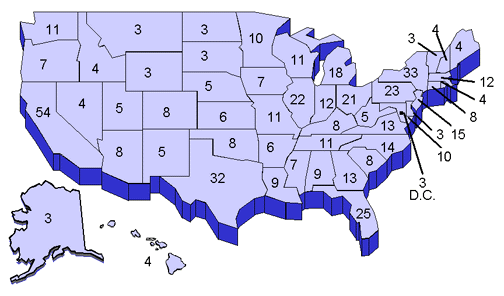
Estimated Gains
Or Losses In Congressional Seats In 2002
Due To Population
Shifts In The 2000 Census
PRO:
Logic of the Electoral
College: it is an additional filtering mechanism. The House is chosen directly;
the Senate is chosen by people chosen by the people; the president was
chosen by people chosen by people who are chosen by the people.
III. Makes for an unequal distribution of power.
The System Actually Works
A. The mathematics:
1. The "Size" Principle: Alan Hivley, "Math
Against Tyranny" Discover, Nov. 1996
B. Application
of Theory
1. 1960 World Series:
| Game |
|
|
|
|
|
|
|
|
|
| Pittsburgh Pirates |
|
|
|
|
|
|
|
|
|
| New York Yankees |
|
|
|
|
|
|
|
|
|

Estimated Gains
Or Losses In Congressional Seats In 2002
Due To Population
Shifts In The 2000 Census
| Arizona +1 | Mississippi -1 |
| California +3 | Nebraska -1 |
| Colorado +1 | Nevada +1 |
| Connecticut -1 | New Hampshire -1 |
| Florida +1 | New York -1 |
| Georgia +1 | Pennsylvania -1 |
| Illinois -1 | Rhode Island -1 |
| Iowa -1 | Texas +3 |
| Massachusetts -1 | Washington +1 |
| Michigan -1 | West Virginia -1 |
![]() Abolish
the Electoral College!
Abolish
the Electoral College!
![]() Failure of the
Electoral College
Failure of the
Electoral College
![]() 1997 Hearings on
Electoral College
1997 Hearings on
Electoral College
Electoral College Dateline
Electoral College Calendar Spring of election year: Each political party chooses electors and alternates in each state according to the number of electors for that state. This is usually done at a state convention.
November (1st Tuesday after the first Monday): Popular vote in each state to determine which party's electors go to the Electoral College.
December: Electoral College meets in each State Capital and in D.C. to cast votes.
January: When Congress
opens, the electoral votes are counted and the election is official if
both the presidential and the vice-presidential candidate have 270 votes.
If no presidential candidate gets the needed 270 votes, the election is
decided in the House of Representatives with each state delegation having
one vote. (26 votes to win) The Senators, voting individually, will elect
the vice-president.
STATES NECESSARY TO ACHIEVE 270 ELECTORAL VOTES:
| CALIFORNIA | 54 |
| NEW YORK | 33 |
| TEXAS | 32 |
| FLORIDA | 25 |
| PENNSYLVANIA | 23 |
| ILLINOIS | 22 |
| OHIO | 21 |
| MICHIGAN | 18 |
| NEW JERSEY | 15 |
| N CAROLINA | 14 |
| GEORGIA | 13 * |
| VIRGINIA | 13 * |
| Total |
|